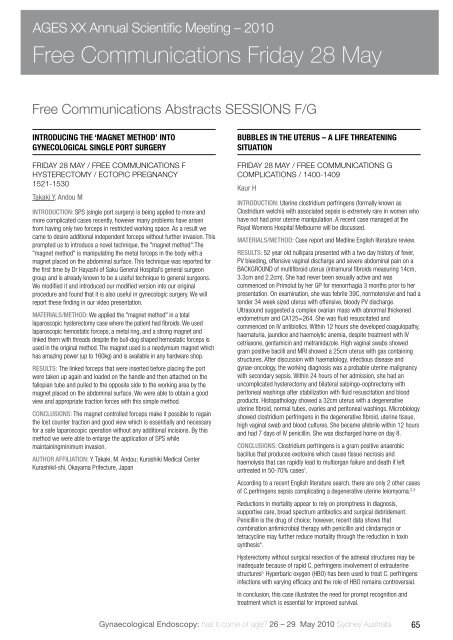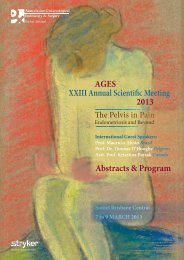Exhibitors - AGES
Exhibitors - AGES
Exhibitors - AGES
You also want an ePaper? Increase the reach of your titles
YUMPU automatically turns print PDFs into web optimized ePapers that Google loves.
<strong>AGES</strong> XX Annual Scientific Meeting – 2010<br />
Free Communications Friday 28 May<br />
Free Communications Abstracts SESSIONS F/G<br />
INTrODUCING ThE ‘MAGNET METhOD’ INTO<br />
GyNECOlOGICAl SINGlE POrT SUrGEry<br />
FRIDAy 28 MAy / FREE COMMuNICATIONS F<br />
hySTERECTOMy / ECTOPIC PREGNANCy<br />
1521-1530<br />
Takaki Y, Andou M<br />
INTRODUCTION: SPS (single port surgery) is being applied to more and<br />
more complicated cases recently, however many problems have arisen<br />
from having only two forceps in restricted working space. As a result we<br />
came to desire additional independent forceps without further invasion. This<br />
prompted us to introduce a novel technique, the "magnet method".The<br />
"magnet method" is manipulating the metal forceps in the body with a<br />
magnet placed on the abdominal surface. This technique was reported for<br />
the first time by Dr Hayashi of Saku General Hospital’s general surgeon<br />
group and is already known to be a useful technique to general surgeons.<br />
We modified it and introduced our modified version into our original<br />
procedure and found that it is also useful in gynecologic surgery. We will<br />
report these finding in our video presentation.<br />
MATERIALS/METHOD: We applied the "magnet method" in a total<br />
laparoscopic hysterectomy case where the patient had fibroids. We used<br />
laparoscopic hemostatic forceps, a metal ring, and a strong magnet and<br />
linked them with threads despite the bull-dog shaped hemostatic forceps is<br />
used in the original method. The magnet used is a neodymium magnet which<br />
has amazing power (up to 160kg) and is available in any hardware shop.<br />
RESULTS: The linked forceps that were inserted before placing the port<br />
were taken up again and loaded on the handle and then attached on the<br />
fallopian tube and pulled to the opposite side to the working area by the<br />
magnet placed on the abdominal surface. We were able to obtain a good<br />
view and appropriate traction forces with this simple method.<br />
CONCLUSIONS: The magnet controlled forceps make it possible to regain<br />
the lost counter traction and good view which is essentially and necessary<br />
for a safe laparoscopic operation without any additional incisions. By this<br />
method we were able to enlarge the application of SPS while<br />
maintainingminimum invasion.<br />
AUTHOR AFFILIATION: Y. Takaki, M. Andou; Kurashiki Medical Center<br />
KurashikiI-shi, Okayama Prifecture, Japan<br />
BUBBlES IN ThE UTErUS – A lIFE ThrEATENING<br />
SITUATION<br />
FRIDAy 28 MAy / FREE COMMuNICATIONS G<br />
COMPlICATIONS / 1400-1409<br />
Kaur H<br />
INTRODUCTION: Uterine clostridium perfringens (formally known as<br />
Clostridium welchii) with associated sepsis is extremely rare in women who<br />
have not had prior uterine manipulation. A recent case managed at the<br />
Royal Womens Hospital Melbourne will be discussed.<br />
MATERIALS/METHOD: Case report and Medline English literature review.<br />
RESULTS: 52 year old nullipara presented with a two day history of fever,<br />
PV bleeding, offensive vaginal discharge and severe abdominal pain on a<br />
BACKGROUND of multifibroid uterus (intramural fibroids measuring 14cm,<br />
3.3cm and 2.2cm). She had never been sexually active and was<br />
commenced on Primolut by her GP for menorrhagia 3 months prior to her<br />
presentation. On examination, she was febrile 39C, normotensive and had a<br />
tender 34 week sized uterus with offensive, bloody PV discharge.<br />
Ultrasound suggested a complex ovarian mass with abnormal thickened<br />
endometrium and CA125=264. She was fluid resuscitated and<br />
commenced on IV antibiotics. Within 12 hours she developed coagulopathy,<br />
haematuria, jaundice and haemolytic anemia, despite treatment with IV<br />
cetriaxone, gentamicin and metranidazole. High vaginal swabs showed<br />
gram positive bacilli and MRI showed a 25cm uterus with gas containing<br />
structures. After discussion with haematology, infectious disease and<br />
gynae-oncology, the working diagnosis was a probable uterine malignancy<br />
with secondary sepsis. Within 24 hours of her admission, she had an<br />
uncomplicated hysterectomy and bilateral salpingo-oophrectomy with<br />
peritoneal washings after stabilization with fluid resuscitation and blood<br />
products. Histopathology showed a 32cm uterus with a degenerative<br />
uterine fibroid, normal tubes, ovaries and peritoneal washings. Microbiology<br />
showed clostridium perfringens in the degenerative fibroid, uterine tissue,<br />
high vaginal swab and blood cultures. She became afebrile within 12 hours<br />
and had 7 days of IV penicillin. She was discharged home on day 8.<br />
CONCLUSIONS: Clostridium perfringens is a gram positive anaerobic<br />
bacillus that produces exotoxins which cause tissue necrosis and<br />
haemolysis that can rapidly lead to multiorgan failure and death if left<br />
untreated in 50-70% cases1 .<br />
According to a recent English literature search, there are only 2 other cases<br />
of C.perfringens sepsis complicating a degenerative uterine leiomyoma. 2,3<br />
Reductions in mortality appear to rely on promptness in diagnosis,<br />
supportive care, broad spectrum antibiotics and surgical debridement.<br />
Penicillin is the drug of choice; however, recent data shows that<br />
combination antimicrobial therapy with penicillin and clindamycin or<br />
tetracycline may further reduce mortality through the reduction in toxin<br />
synthesis 4 .<br />
Hysterectomy without surgical resection of the adnexal structures may be<br />
inadequate because of rapid C. perfringens involvement of extrauterine<br />
structures 5. Hyperbaric oxygen (HBO) has been used to treat C. perfringens<br />
infections with varying efficacy and the role of HBO remains controversial.<br />
In conclusion, this case illustrates the need for prompt recognition and<br />
treatment which is essential for improved survival.<br />
gynaecological endoscopy: has it come of age? 26 – 29 May 2010 Sydney Australia<br />
65

















